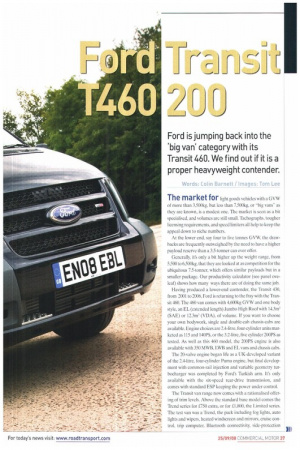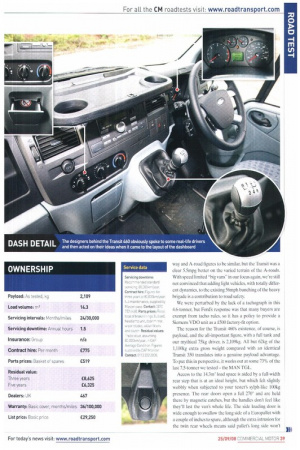Ford is jumping back into the 'big van' category with
Page 37

Page 38

Page 39

Page 40

If you've noticed an error in this article please click here to report it so we can fix it.
its Transit 460. We find out if it is a proper heavyweight contender.
Words: Crain Barnett / Images: Tom Lee The market for light goods vehicles with a GVW of more than 3,500kg, but less than 7,500kg, or "big vans" as they are known, is a modest onc. The market is seen as a bit specialised, and volumes are still small. Tachographs, tougher licensing requirements, and speed limiters all help to keep the appeal down to niche numbers.
At the lower end, say four to live tonnes GVW, the drawbacks are frequently outweighed by the need to have a higher payload reserve than a 3.5-tonner can ever offer.
Generally, it's only a bit higher up the weight range, from 5,500 to 6,500kg, that they are looked at as competition for the ubiquitous 7.5-tonner, which offers similar payloads but in a smaller package. Our productivity calculator (see panel oveleaf) shows how many ways there are of doing the same job.
Having produced a lower-end contender, the Transit 430, from 2001 to 2006. Ford is returning to the fray with the Transit 460, The 460 van comes with 4,600kg GVW and one body style, an EL (extended length) Jumbo High Roof with 14.3m3 (SAE) or 12.3m3 (VDA), of volume. If you want to choose your own bodywork, single and double-cab chassis-cabs are available. Engine choices are 2.4-litre, four-cylinder units marketed as 115 and 140PS, or the 3.2-litre, five cylinder 200PS as tested. As well as this 460 model, the 200PS engine is also available with 350 MWB, LWB and EL vans and chassis cabs.
The 20-valve engine began life as a UK-developed variant of the 2.4-litre, four-cylinder Puma engine, but final development with common-rail injection and variable geometry turbocharger was completed by Ford's Turkish arm, It's only available with the six-speed rear-drive transmission, and
-;; comes with standard ESP keeping the power under control.
_ — • The Transit van range now comes with a rationalised offer
-7,7 ing of trim levels. Above the standard base model comes the Trend series for £750 extra, or for £1,800, the Limited series. The test van was a Trend, the pack including fog lights, auto lights and wipers, heated windscreen and mirrors, cruise control, trip computer, Bluetooth connectivity, side-protection mouldings and body-coloured grille. Other options range from £600 for air-con to €200 for a rear-bumper step with parking sensors and so on.
On the road
We knew the Transit would be quick, and we weren't disappointed. A standstill to 50mph figure of 14.4 seconds is brisk, but not record breaking. A large part of this is down to a self-protection system that limits torque in first gear. On the move, the 20mph increments fly by.
Ironically, the highest-powered engine is less suited to the 4.6-tonner than for an unrestricted 3.5-tonner. Accelerating through the gears sees you almost hit the limiter in third gear, with three more to go. Fifth and sixth are effectively overdrives. On the open A-road sections, though, the torque of the five-pot engine and the handling of the double rear-wheel chassis combines to allow the Transit to drive almost everywhere at 50mph.
The engine is turning at 2,250rpm on the limiter in top gear, well short of the top end of the torque plateau and exactly halfway to the red line.
The ride is firm, although it tended to float when it encountered certain low frequency road surface undulations, and the steering proved precise. Hill Hold is fitted, although it isn't indicated by a switch, and helped the van to easily restart on the l-in-3 test hill. The parking brake wouldn't quite hold on the l-on-4 before it ran out of travel.
Productivity
The fuel economy expectation for this class of vehicle in this world of speed limiters is based only on the Volkswagen Crafter CR50, which achieved 23.6mpg overall. With half a tonne less mass to move, we were expecting the Transit to improve on this, but it turned in just 23.5mpg.
While the overall figure was mildly disappointing, the section figures were more mystifying. We'd expect the motor
way and A-road figures to be similar, but the Transit was a clear 5.5mpg better on the varied terrain of the A-roads. With speed limited -big vans" in our focus again, we're still not convinced that adding light vehicles, with totally different dynamics, to the existing 56mph bunching of the heavy brigade is a contribution to road safety.
We were perturbed by the lack of a tachograph in this 4.6-tonner, but Ford's response was that many buyers are exempt from tacho rules, so it has a policy to provide a Siemens VDO unit as a .E500 factory-fit option.
The reason for the Transit 460's existence, of course, is payload, and the all-important figure, with a full tank and our mythical 75kg driver, is 2,109kg, All but 62kg of the 1,100kg extra gross weight compared with an identical Transit 350 translates into a genuine payload advantage. To put this in perspective, it works out at some 73% of the last 7,5-tonner we tested — the MAN TOL.
Access to the 14.3m3 load space is aided by a full-width rear step that is at an ideal height but which felt slightly wobbly when subjected to your tester's sylph-like 100kg presence. The rear doors open a full 270° and are held there by magnetic catches, but the handles don't feel like they'll last the van's whole life. The side loading door is wide enough to swallow the long side of a Europallet with a couple of inches to spare, although the extra intrusion for the twin rear wheels means said pallet's long side won't quite fit between the arches. Some hefty tie-down rings were complemented on the test van by the optional waistheight load-restraint rails (i45).
Cab comfort
The doors on the Transit don't open as far as you'd expect, and they bounce back off the hinge stops. Things improve once you're aboard. Apart from the fixed steering column, there's little for a driver to criticise, the interior having been designed in consultation with real users.
It's a long reach to the parking brake, but the dashmounted gear lever is readily to hand and works smoothly. The park brake lever on our example had a habit of popping up from its off position enough to light the dashboard warning lamp, but annoyingly, disengaged the cruise control — only solved by wedging a bag between the seats.
Beyond the small car-like steering wheel, the instrument panel is clearly laid out, with speedo, rev counter and fuel and temperature gauges surrounding the trip computer display. Functions include fuel and speed data and an alarm clock. Oddly for Ford, the display is not easy to read without perfect sight. Column stalks are of a conventional layout and the Trend's automatic lights and wipers will stop the stalks wearing out too soon.
The interior is tastefully trimmed with materials that are mainly grey apart from the black dash panel. The scats are well shaped, with full three-point inertia reel seat belts and soft-trimmed height-adjustable head restraints, but there are none of the fold-down table tricks of its rivals. Also, wheel arch and centre console intrusion is such that the driver struggles to get his feet comfortable.
There is a comprehensive audio system, including radio,
The matching tray on the driver's side houses one of three 12V power sockets, with one more on the dash and another in the load area. Between the two trays is the handy fold-back dining table, although this would be lost if a tachograph was fitted. The glovebox is able to swallow an A4 clipboard with ease, and the empty passenger airbag
housing creates a small, open bin.
The only minor switches on the dash are for windscreen heat and ESP override. Interior lights are on the small side and look a hit cheap. The dual door mirrors aren't the biggest on the market, but they provide a decent field of view. In-cab noise levels are respectably. low, although the pleasantly gruff off-beat soundtrack of the five-cylinder engine is always available. •




































































































































































